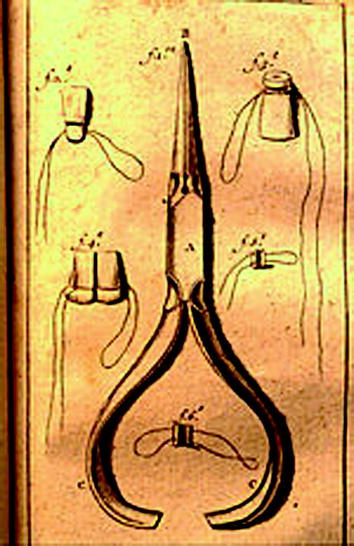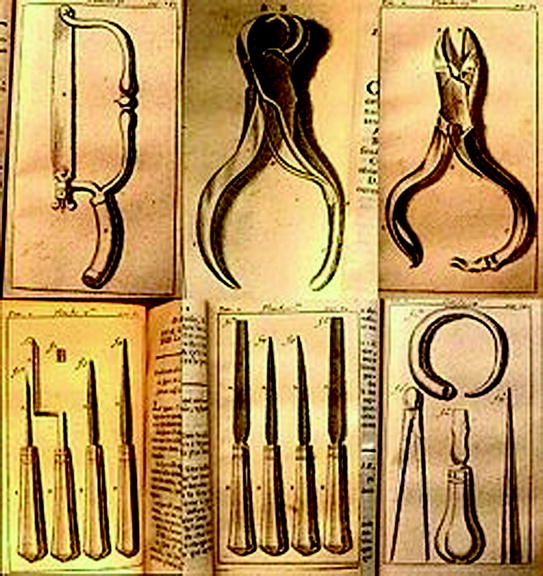Fig. 1.1
Image of a mandible with dental prosthetics done by Etruscans
In the 18th century, the prosthetic materials used were human teeth themselves, animal teeth carved as human teeth, ivory and porcelain. The total prosthesis used by the first American president George Washington was carved out of hippopotamus ivory. Pierre Fauchard was the first dentist to write a dental book and to develop several dental instruments for prosthetics and orthodontics (Figs. 1.2, 1.3 and 1.4).




Fig. 1.2
Portrait of Pierre Fauchard

Fig. 1.3
First prosthodontics plier developed by Pierre Fauchard

Fig. 1.4
Prosthodontics tools by Pierre Fauchard
Europeans only managed to master the technique of making porcelain in the 1720s and the first porcelain denture was made in 1774 by the Parisian pharmacist Alexis Duchateau. Since then, the dental prosthesis was continually perfected. The first crowns and fused feldspathic porcelain inlays were made in 1886, evolving in the 1950s with the introduction of leucite (a potassium and aluminum silicate—KAlSi2O6), improving the properties of crowns and ceramic restorations. All-ceramic prostheses, however, have only become available on market in the 1980s.
Dentists and materials scientists have sought over time to reconcile mechanical performance with esthetics. An analysis of scientific articles published between 1981 and 1999 in The Journal of Prosthetic Dentistry shows that the major concern has been with the mechanical aspects of the prostheses. Since then the evolution of ceramic biomaterials as prosthetic materials is concerned with getting the most esthetic result possible, without causing damage to the opposing tooth enamel and presenting adequate mechanical performance.
The use of ceramics as a prosthetic material has evolved from the metal-ceramic restorations used since the 1960s, opalescent ceramics (with the addition of oxides in the size of the wavelength of visible light), DICOR® ceramics (45 % glass and 55 % mica) to InCeram® ceramics (glass infused, partially sintered alumina).
Most of these ceramics are composed of leucite crystals dispersed in a glassy matrix. Leucite has a high coefficient of thermal expansion and raises the overall thermal expansion of the bulk porcelain leading to thermal compatibility with metal frameworks. The amount of leucite and the amount and composition of glass determine decisively the coefficient of thermal expansion of the final product.
The esthetic limitations of metal-ceramic restorations have triggered the development of new all-ceramic materials which can be used for both single restorations and short-span fixed partial dentures. Currently, many all-ceramic systems are commercially available and most offer superior esthetics, since they allow for light transmission in a manner similar to those of natural dental structures.
Stay updated, free dental videos. Join our Telegram channel

VIDEdental - Online dental courses


